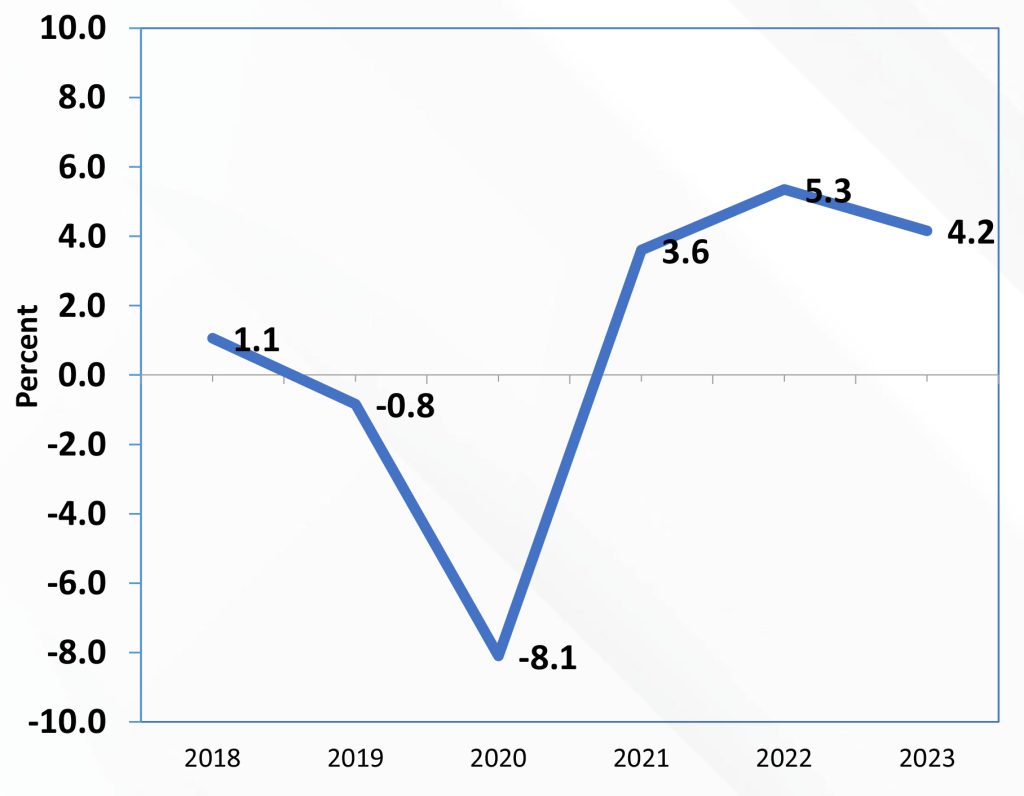… even though economy grew to N$227 billion in 2023
Economist foresee challenges ahead for jobseekers, as the pace at which the economy is growing has notably slowed over the past year.
Despite Namibia’s gross domestic product (GDP) increasing to N$227 billion in 2023 from N$205 billion in 2022, the economy’s momentum has declined, figures released by the Namibia Statistics Agency (NSA) yesterday show.
The pace at which the economy is growing has notably slowed, dropping from a robust 5,3% in 2022 to a more sluggish 4,2% last year.
Economist Josef Sheehama says this slow economic growth raises concerns about the resilience and sustainability of Namibia’s economic expansion amid evolving global and domestic challenges.
“This means the employment rate decreases as there is less economic activity,” he says.
The NSA figures indicate that the slow economic performance stemmed from slower growth across key sectors.
“Despite the economic recovery in 2022, the socio-economic situation did not improve significantly. Employment is estimated to remain below pre-pandemic levels as labour-intensive manufacturing subsectors have added jobs relatively slowly,” Sheehama says.
He says inflation has surged, predominantly driven by elevated fuel prices.
“Therefore, there is no excitement for the time being unless the country comes up with other economic activities to boost GDP,” Sheehama says.
Economist Omu Kakujaha-Matundu says the pace of economic growth in 2023 compared to 2022 is somewhat concerning.
He says it’s evident that more efforts to significantly reduce unemployment and poverty levels are required.
“There is a pressing need to embark, for instance, on the special economic zones and kick off the green schemes in all earnest,” he says.

ECONOMIC PERFORMANCE
During a press conference at Katima Mulilo yesterday, deputy NSA statistician general Ottillie Mwazi revealed that the mining and quarrying sector was the biggest sector in the economy in 2023, contributing 14,4% to GDP, followed by manufacturing (11,2%) and wholesale (11%).
Mwazi said the mining and agriculture sectors recorded slower growth of 9,7%, while sectors such as manufacturing, construction, and processing recorded a slow growth of 2%.
“The improved performance in the industries is observed across major sectors in the tertiary industries, except for public ‘administration and defence’, which came under pressure due to the government’s fiscal consolidation policy aimed at reducing expenditure,” she said.
Mwazi said private household consumption expenditure, which accounts for 73,3% of GDP, posted a growth of 4,7%, compared to 9,5% in 2022.
Additionally, she revealed that the gross fixed capital formation accelerated on the back of increased expenditure in oil and gas exploration, showing an increase of 69,3% in 2023 in comparison to 10% registered in 2022.
Trade statistician Ezekiel Kombomde, who presented Namibia’s international merchandise statistics, said during 2023, the country exported N$104 billion worth of goods and imported goods worth N$137 billion.

He said trade in the Zambezi region makes up 10% of the export share, saying this comprises N$10,4 billion at the Katima Mulilo border post and N$2,2 billion at the Ngoma border post.
He said goods exported through the Katima Mulilo border post in 2023 are fish (N$2 billion), tyres used in construction and mining (N$809 million), as well as bars and rods of alloy steel (N$793 million).
Kambonde said goods imported in the Zambezi region makes up 2% of national imports, as the Katima Mulilo border post imported goods valued at N$2,4 billion, and the Ngoma border post imported goods valued at N$714 million.
He said goods mostly imported are cobalt oxides and hydroxide (N$956 million) nickel ores and concentrates (N$853 million), and soya beans (N$222 million).
IJG research analyst Angelique Bock says the overall economic performance in 2023 remains positive.
She says although the growth rate dropped to 4,2% from the higher base established in 2022, the overall trajectory is still favourable, considering the 5,3% growth in 2022 stemmed from a lower starting point.
“Going forward, we can expect a slightly lower growth rate, but this will depend on the revisions made going forward,” Bock says.
Stay informed with The Namibian – your source for credible journalism. Get in-depth reporting and opinions for
only N$85 a month. Invest in journalism, invest in democracy –
Subscribe Now!






